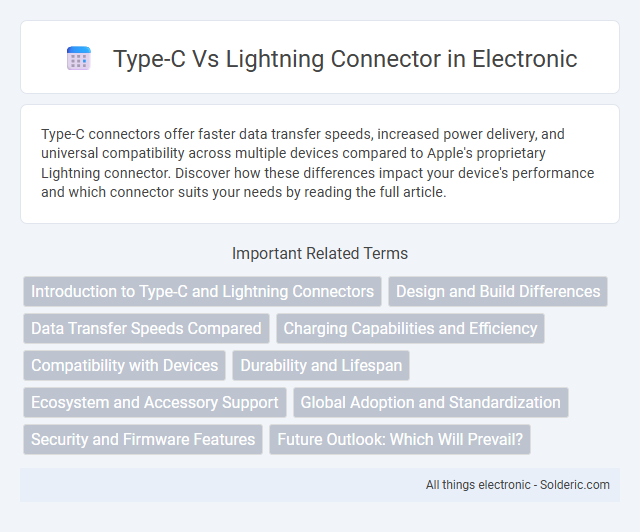Type-C connectors offer faster data transfer speeds, increased power delivery, and universal compatibility across multiple devices compared to Apple's proprietary Lightning connector. Discover how these differences impact your device's performance and which connector suits your needs by reading the full article.
Comparison Table
| Feature | Type-C Connector | Lightning Connector |
|---|---|---|
| Manufacturer | USB Implementers Forum | Apple Inc. |
| Introduced | 2014 | 2012 |
| Reversibility | Yes, reversible | Yes, reversible |
| Maximum Power Delivery | Up to 100W (USB Power Delivery) | Up to 12W (standard), higher with proprietary tech |
| Data Transfer Speed | Up to 40 Gbps (Thunderbolt 3/4) | Up to 480 Mbps (USB 2.0) |
| Compatibility | Universal, supports multiple devices and brands | Apple devices only (iPhone, iPad, iPod) |
| Audio/Video Support | Supports audio, video, and alternate modes (e.g., DisplayPort) | Limited audio and video pass-through |
| Durability | Robust, designed for frequent use | Durable, but less so than Type-C |
| Adoption in Devices | Modern Android smartphones, laptops, tablets, peripherals | Exclusive to Apple mobile devices |
Introduction to Type-C and Lightning Connectors
Type-C connectors feature a reversible design and support high-speed data transfer, power delivery up to 100 watts, and compatibility with various devices, making them a versatile standard in modern electronics. Lightning connectors, developed by Apple, provide a compact, reversible interface primarily used for charging and data transfer in iPhones, iPads, and other Apple accessories. Both connectors serve essential roles in device connectivity but differ significantly in universality and supported technologies.
Design and Build Differences
The Type-C connector features a symmetrical, reversible design with a slim, oval shape that supports higher data transfer speeds and power delivery up to 100W, making it ideal for modern devices. The Lightning connector, proprietary to Apple, is also reversible but has a smaller, more compact form with eight pins, designed specifically for streamlined compatibility with Apple products. Your choice between the two will depend on device compatibility and the need for enhanced performance in charging and data transfer.
Data Transfer Speeds Compared
Type-C supports data transfer speeds up to 40 Gbps with Thunderbolt 3 or USB4 protocols, significantly outperforming Lightning connectors, which max out at USB 2.0 speeds of 480 Mbps. This makes Type-C ideal for high-bandwidth tasks such as 4K video transfer and fast file synchronization. Lightning connectors, proprietary to Apple, are limited by older standards that restrict data throughput compared to the versatile Type-C interface.
Charging Capabilities and Efficiency
Type-C connectors support higher power delivery up to 100W, enabling faster charging for a wide range of devices including laptops and smartphones. Lightning connectors typically deliver lower wattage, around 20W, which limits charging speed compared to Type-C. The reversible design and USB Power Delivery (USB-PD) protocol compatibility of Type-C enhance charging efficiency and device interoperability.
Compatibility with Devices
Type-C connectors offer broad compatibility across numerous devices including smartphones, laptops, tablets, and gaming consoles, supporting fast data transfer and charging protocols. Lightning connectors are proprietary to Apple products such as iPhones, iPads, and some accessories, limiting their use to Apple's ecosystem. Your choice between Type-C and Lightning should consider the devices you use most often and the convenience of a single cable for multiple gadgets.
Durability and Lifespan
Type-C connectors are designed with reversible plugs and robust construction, featuring reinforced internal pins that enhance durability against frequent insertions and removals. Lightning connectors, while compact and proprietary, often experience wear and tear due to thinner pins and less resilient housing, which can reduce their lifespan under heavy use. Overall, Type-C connectors typically offer superior durability and longer lifespan, making them more reliable for daily charging and data transfer needs.
Ecosystem and Accessory Support
Type-C connectors benefit from widespread adoption across multiple device categories, including smartphones, laptops, tablets, and peripherals, resulting in extensive ecosystem compatibility and a large variety of accessories. Lightning connectors remain exclusive to Apple devices, limiting accessory options primarily to Apple-certified products and reducing cross-brand compatibility. The universal nature of Type-C enhances user convenience by supporting standardized chargers, docks, and data transfer cables across many brands and device types.
Global Adoption and Standardization
Type-C connectors have achieved widespread global adoption due to their universal compatibility with numerous devices and support from major technology companies, making them a standard in charging and data transfer interfaces. Lightning connectors remain predominantly used within Apple's ecosystem, limiting their global standardization despite offering optimized performance for Apple products. The broad industry backing for USB Type-C ensures a more unified and standardized approach across diverse brands and platforms worldwide.
Security and Firmware Features
Type-C connectors incorporate advanced security protocols such as USB Power Delivery Authentication and support for firmware updates that enhance device protection and prevent unauthorized charging or data access. Lightning connectors, developed by Apple, utilize proprietary authentication chips to secure data transfer and charging, but firmware updates are typically managed through iOS rather than the hardware interface. USB Type-C's widespread adoption and standardized security features offer greater flexibility for firmware-based security enhancements across various device manufacturers.
Future Outlook: Which Will Prevail?
Type-C connectors are rapidly becoming the global standard due to their universal compatibility, faster data transfer speeds up to 10 Gbps, and support for higher power delivery up to 100W, making them suitable for a wide range of devices beyond smartphones. Lightning connectors remain prevalent in Apple ecosystems but face limitations in adoption outside of Apple products, and regulatory pressures, such as the European Union's mandate for USB-C in all mobile devices by 2024, strongly favor Type-C's future dominance. The combination of broader industry support, regulatory endorsement, and superior technical specifications positions USB-C to ultimately prevail as the universal charging and data transfer standard.
Type-C vs Lightning Connector Infographic

 solderic.com
solderic.com